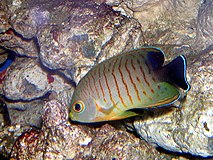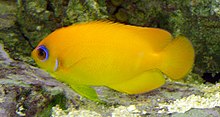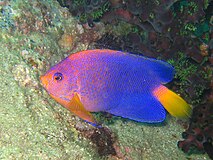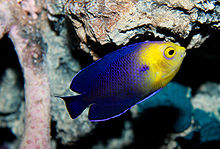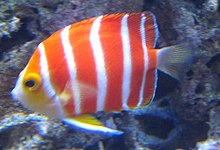Pygmy angelfish
| Pygmy angelfish | ||||||||||||
|---|---|---|---|---|---|---|---|---|---|---|---|---|

Flame angelfish |
||||||||||||
| Systematics | ||||||||||||
|
||||||||||||
| Scientific name | ||||||||||||
| Centropyge | ||||||||||||
| Kaup , 1860 |
The pygmy angelfish ( Centropyge ) or duke fish comprise over 30 species .
Almost all species live in the coral reefs of the Indo-Pacific . Centropyge argi and Centropyge aurantonotus live in the tropical western Atlantic, from the Caribbean to the Brazilian coast. Centropyge resplendens lives in isolation near Ascension Island in the Atlantic. A pygmy angelfish of the East Coast of Africa and the Oman, Yemen area is Centropyge acanthops .
features
They become six to 19 centimeters long, depending on the species. Like all angelfish, they have the typical thorn at the bottom of the gill cover and are high-backed and flattened on the sides. The dorsal fin is continuous. Most species are brightly colored, but there are also darkly colored representatives, such as Centropyge nox . A different coloring of the juvenile fish as with many other angelfish does not exist in the dwarf angelfish.
Way of life
Dwarf angelfish live in pairs or in harem groups, that is, a male with several females, hidden between coral stocks. The animals mainly feed on algae, but they also eat small crustaceans.
Blue and yellow pygmy angelfish ( C. bicolor ), in the background Barber's anemonefish ( Amphiprion barberi ) with the symbiotic anemone Entacmaea quadricolor .
Striped angelfish ( C. bispinosa )
Eibl's dwarf angelfish ( C. eibli )
Lemon angelfish ( C. flavissima )
Japanese angelfish ( C. interrupta )
Brown angelfish ( C. multispinis )
Blue angelfish ( C. argi )
Cook angelfish ( C. boylei )
Systematics
The dwarf angelfish are one of the eight species of angelfish. They are divided into two sub-genera, Centropyge and Xiphypops .
So far 33 species have been described. Since many live very hidden, new species could still be discovered. On the other hand, some species are very similar and they could be local color variants of already known species. In the wild, hybrids between different species have also been detected. These crossings could also be described as new species. New discoveries are made primarily at greater depths between 50 and 150 meters.
- Subgenus Centropyge
- Centropyge from Allen, Young & Colin, 2006
- Golden stripe angelfish ( Centropyge aurantia ) Randall & Wass 1974
- Blue-and-yellow angelfish ( Centropyge bicolor ) (Bloch 1787)
- Striped angelfish ( Centropyge bispinosa ) (Günther 1860)
- Centropyge cocosensis Shen, Chang, Delrieu-Trottin & Borsa, 2016
- Colin's angelfish ( Centropyge colini ) Smith-Vaniz & Randall 1974
- Mauritius blue angelfish ( Centropyge debelius ) Pyle 1990
- Centropyge deborae Shen, Ho & Chang, 2012
- Eibl's dwarf angelfish ( Centropyge eibli ) Klausewitz 1963
- Rusty angelfish ( Centropyge ferrugata ) Randall & Burgess 1972
- Moonbeam angelfish ( Centropyge flavipectoralis ) Randall & Klausewitz 1977
- Lemon angelfish ( Centropyge flavissima ) (Cuvier 1831)
- Heralds pygmy angelfish ( Centropyge heraldi ) Woods & Schultz 1953
- Easter Island angelfish ( Centropyge hotumatua ) Randall & Caldwell 1973
- Japanese angelfish ( Centropyge interrupta ) (Tanaka, 1918)
- Coconut angelfish ( Centropyge joculator ) Smith-Vaniz & Randall 1974
- Flame angelfish ( Centropyge loricula ) (Günther 1874)
- Multicolored pygmy angelfish ( Centropyge multicolor ) Randall & Wass 1974
- Brown angelfish ( Centropyge multispinis ) (Playfair 1867)
- Nahacky's dwarf angelfish ( Centropyge nahackyi ) Kosaki 1989
- Anesthetic pygmy angelfish ( Centropyge narcosis ) Pyle & Randall 1993
- Three-eyed angelfish ( Centropyge nigriocella ) Woods & Schultz 1953
- Midnight angelfish ( Centropyge nox ) (Bleeker 1853)
- Potter's angelfish ( Centropyge potteri ) (Jordan & Metz 1912)
- Shepard's angelfish ( Centropyge shepardi ) Randall & Yasuda 1979
- Keyhole angelfish ( Centropyge tibicen ) (Cuvier 1831) ( type species )
- Pearl-scale angelfish ( Centropyge vrolikii ) (Bleeker 1853)
- Woodheads angelfish ( Centropyge woodheadi ) Kuiter, 1998
- Subgenus Xiphypops , Jordan, 1922
- Orange-backed angelfish ( Centropyge acanthops ) (Norman 1922)
- Blue angelfish ( Centropyge argi ) Woods & Kanazawa 1951
- Yellow bridge angelfish ( Centropyge aurantonotus ) Burgess, 1974
- Hawaiian angelfish ( Centropyge fisheri ) (Snyder 1904)
- Ascension angelfish ( Centropyge resplendens ) Lubbock & Sankey 1975
- possibly to the genus Paracentropyge Burgess, 1991
- Cook's angelfish ( Centropyge boylei ) Pyle & Randall, 1992
- Centropyge venusta (Yasuda & Tominaga, 1969)
Aquarium keeping
Dwarf angelfish are much more suitable for keeping in saltwater aquariums than the great angelfish of the genus Pomacanthus . Even in the wild you only have a few square meters of territory and adapt better to the cramped conditions in the aquarium. Since the animals are hermaphrodites , the composition of the pairs is not a problem if you buy two animals whose sizes are significantly different. The smaller animal becomes a female while the larger one becomes a male. The tendency of many specimens to nibble on the corals can be problematic. This is different for individual individuals and does not depend on the species. A coral-eating angelfish can destroy an aquarium in a few days.
literature
- Frank Schneidewind: Kaiserfische , 1999, Tetra Verlag, ISBN 3-89745-137-9
- Roger C. Steene: Butterfly and Angelfish, Volume 1 , 1977, Mergus Verlag, ISBN 3-88244-001-5
- Gerald R. Allen: Butterfly and Angelfish, Volume 2 , 1979, Mergus Verlag, ISBN 3-88244-002-3
- BW Bowen, A. Muss, LA Rocha, & WS Grant: Shallow mtDNA Coalescence in Atlantic Pygmy Angelfishes (Genus Centropyge) Indicates a Recent Invasion from the Indian Ocean. Journal of Heredity 2006 97 (1): 1-12; doi : 10.1093 / jhered / esj006
annotation
- ↑ "Stingling prick" (cf. Pygocentrus ), here even "prickly pusher" - because the rectum on the first anal fin spine runs to its tip.
Web links
- Angelfish on Fishbase.org (English)


